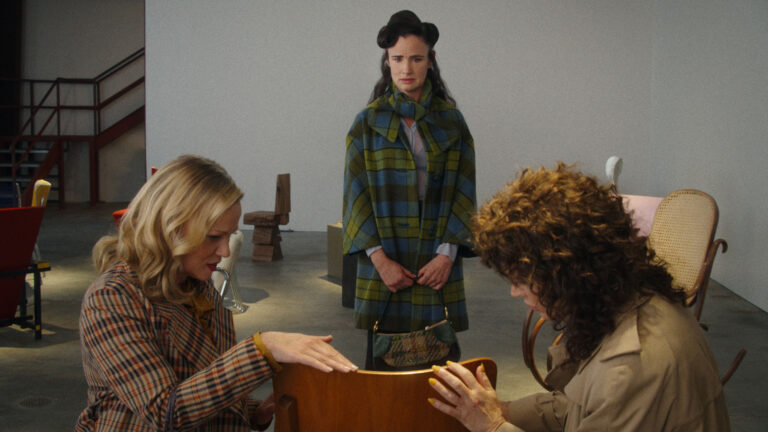“By Design” (playing in the NEXT program at the 2025 Sundance Film Festival) is one of the few films screened at the fest that actually has a unique voice attached to it. Through director Amanda Kramer’s odd vision, the film has an absurd tone, as so are a handful of her projects, yet with reason and purposefully made in a shoddy fashion, which might make many viewers question her intent of utilizing (and mocking simultaneously) tropes regularly seen in cinema, literature, and personation (or performance arts)—pretending to be someone to deceive. But when you look back at the “Please Baby Please” director’s catalog, you notice that this “mockery” or trope manipulation has always been present, although with different undertones and intents, all centered in the themes of liberation, personal freedom, and desires through radicality, which “By Design” opts in to make the narrative a play in innuendo.
Amanda Kramer and Her Tongue-in-Cheekness
Amanda Kramer is one of the few independent acts in modern cinema who has found her niche easily and quickly, a rarity in today’s age of “copy and paste” procedures. Tongue-in-cheekness blends with a personal touching point to make up a witty and smoothly scripted dialogue that, although it seems from another version of reality, is quite poignant in its thoroughlining. This is something that both John Waters and Kenneth Anger—both of whom, like Kramer, gained popularity through the cult independent markets and found their respective voices relatively early in their careers—utilize in their screenwriting, imagery, and direction. However, Kramer does not dwell on Waters’s outlandish dirtiness or Anger’s viscerality.
Tamer than the aforementioned, yet she is not afraid to be angsty or fiery to make her points more striking, like with the involvement of the motorcycle gang in “Please Baby Please,” led by Karl Glussman’s leather-bound, mesh-top-wearing, and kink machine Teddy, or the screaming matches by the trapped young girls in “Ladyworld.” In “By Design,” Kramer does not provide that angst or expressive fury that made her work so entrancing and, somehow, intoxicating. But what she misses in fury, Kramer provides in (necessary) opaqueness, to which it works both to its benefit and against, all while remaining a touching and odd experience in a festival slate lacking such distinction or “trial and error” cinematic bravery testing.
Amanda Kramer’s world in “By Design” is not in the same vein as the one we inhabit. Everything is detailed yet disorganized, literally and metaphorically. You notice this in the sets and locations of Grace Surnow and Anjélica Vasquez. These rooms, spare of excess and crammed in a madcap of drowning emotions, define the style and essence that characterizes Kramer as an eccentric, bold storyteller. In addition, it also tells us, from the get-go, the path her film is going to take and to what extent the absurdity is going. “Ladyworld” shows the chaos and feminine urge by creating a suffocating house, each minute limiting the space in which the characters, trapped there without electricity and their food and water supplies get cut short quickly, interact.
The Detail and Specification on the Locations
In “Please Baby Please,” Kramer plays with neon lighting, leather-bound costumes, and objects to switch from purity to ultimate self-expression. “By Design,” however, is less playful than her previous features in terms of aesthetics and splashes of color. (Her last two films, “Give Me Pity!” and “So Unreal” use a very rousing color palette, ranging from luscious pink and violet hues, combined with ’80s-like headlights and sparkle to “Tron”—inspired visuals that would make Director Steven Lisberger proud.) Here, plaid greys and wood browns are central to the look Kramer wants to adopt as part of her making this world look, feel, and seem rudimentary, even though her film is far from it. Instead of leather clothing, each character has their own garments with a light, yet distinguishable, pop of color.
Instead of multiple accessories, there are some props or objects that Surnow and Vasquez place in the background to add more definition to this confusing, palpable setting. Household items and furniture have played an essential part in Kramer’s filmography. Dirty dishes that Harry Melling’s Arthur (“Please Baby Please”) cleans, symbolizing the switch and break of gender roles; a bed frame that divides the trapped girls into two “Lords of the Flies” groups; a long couch that serves as the distance between two teenage girls, Lo (Gina Piersanti) and Dot (Lucia Ribisi) (“Bark”). And “By Design” has a chair. It is not just any chair, at least from Camille’s (Juliette Lewis) perspective, who sees something in it that she does not see in herself: value.
Many see this chair as an excellent piece of polished woodwork with a special touch nobody can pinpoint. But Camille admires the designer chair due to its presentation and allure, having the ability to pull eyes to itself without effort. It stays silent and has more attention and admiration than she will ever have. She first sees this chair in a showroom after having lunch with two other guests—Lisa (Samantha Mathis) and Irene (Robin Tunney)—and she’s uncomfortable during their nonsensical chats. Camille does not get a word out during these meetings, garnering the look of a lost soul, a woman disappointed and saddened with her life. An omniscient narrator (voiced by Melanie Griffith) says that isn’t the case.
Juliette Lewis Shines in Her Solid yet Underused Performance
Camille is happy and satisfied with her life, secure in every way. But she sees herself becoming that “prized” object that many desire, admittedly wanting to find a way to switch places with it. And so, like a “be careful what you wish for” mysticality, Camille and the chair switch places. Her body remains intact, while her soul becomes attached to the chair. Camille’s physical body ends as an empty vessel, to which friends and colleagues visit yet never realize there’s nothing there. Her soul, the ethereal side of her, links to a prized possession, looked at, admired wholly in all of its features, and appreciated for its worth and more. Kramer focuses more on her soul’s trajectory, the path the driver of our essence takes upon this transition. However, she is still curious and concerned for the body.
The first act sets up the fatuity that lingers in “By Design,” with many moments of feeling instead out of place due to their tonal discrepancy or elaborated, quite interestingly enough, by its focus on the human amidst the deadpan and metatextual. It also is one of the few moments Lewis, an underrated actress I have loved since Kathryn Biglelow’s “Strange Days,” gets moments to shine. The great majority of the film relies on this separation of the body. During her screen time, as the un-separated Camille, Lewis is rather excellent. She shows signs of vulnerability, hopefulness, and curiosity all in one glance at a chair. Lewis is notable for her superb character work, which Kramer does so well in guiding her cast to match her style, tone, and underlying emotions.
It is like a mask behind the mask situation of complex, chameleonic characters. For most of her career, she has been placed in films that do not benefit from her strengths. An example is Juliette Lewis and her stellar work in Oliver Stone’s “Natural Born Killers,” a film I despise plenty and dislike even more because it wastes such a great performance on shoddy material. She is not near to being the problem with it. The issue lies in Oliver Stone and producer Don Murphy’s botch of the original story and how they messed it up out of spite. But Kramer, who lets her actors play a little in her sandbox while maintaining a sense of realism, places Lewis again in her comfort zone. And a great, albeit underused, performance comes out of it.
Aimless Souls and The Value of Our Possessions
The chair containing Camille’s soul is now headed toward Olivier’s (Mamoudou Athie) residence. He is a jazz pianist who recently separated from his longtime girlfriend, Marta (Alisa Torres). And she gifted him the luxury piece as a departing gift. Unlike Camille, Olivier is a sad man. He is yearning for the lovelorn desire of wanting to reunite with his ex-partner. His residence immediately reeks of desolation and isolation. A simple, designer chair becomes the star of the show. It now adds vibrancy and personality to the muted color palette in his residence’s walls. Again, the play and focus on location help to expand Kramer’s strange world. As what happened with Camille, Olivier becomes captivated by the chair. He senses something odd about it, something that he believes will help him during this treacherous time.
Olivier then heads on a journey searching for hope and the root of this chair’s magnetism. Meanwhile, Camille is at the center of this allure, being examined, admired, and loved, at long last getting what she always wanted. Kramer questions how these characters reflect their lives and purpose in such a controlled time, being stripped of their liberation. Using a chair also hints at indefinite notions about modern-day consumerism and the value we put on our possessions, whether it is about money (literal value) or how it ties with us emotionally. The two notions that Kramer points out meld together to form an affecting love story through mere glances. Most of the dialogue in “By Design” is never received.
A soulless carcass does not respond, and a chair does not have a mouth to reply. This division of framing Camille’s visits spilling their guts, to no avail of response but to have someone to listen to their issues and complaints, and Olivier seeking answers does provide the film an evocativeness that is easy to get a hold of. Instead, some of the dialogue does feel quite too in your face and heavy-handedly fed to the viewer, which serves Kramer’s efforts of using tropes and cliches through camp. However, sometimes, it feels clunky than purposefully placed together in that fashion and tone.
To its benefit, these scenes are too far between the main point and the narrative threshold. Kramer can get away with it slightly due to her unique approach and aesthetic. “By Design” initially strives because, although not only, of Lewis’ performance. But once it departs from her, Kramer uses her personality to create images, lensed by her usual DP, Patrick Meade Jones, that seems odd and nearing the thin line of absurd and incoherent and still contain plenty of emotion by her visual aesthetic.
“By Design” screened at the 2025 Sundance Film Festival in the NEXT section of the festival.



